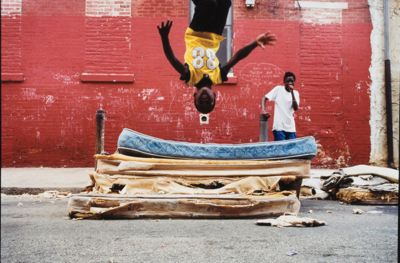Every once in a blue moon you get surprised by an exhibit that takes your breath away. Kiki Smith did it to me in 2006 and last year Glenn Ligon did exactly the same.
But last week I had the chance to catch Zoe Strauss’ exhibit, “Ten Years”, at the Philadelphia Museum of Art, and there I was walking around in circles, revisiting works multiple times, looking into details I missed on the first and second go-round. Is it a coincidence that Strauss’ 2008 book, America, just happens to hold the same title as the Glenn Ligon show from last year? I wonder.
This mid-career retrospective was epic, not in breadth or scale, but in the quality of composition and the framing of content. Strauss, who as an untrained photographer explores “the most disenfranchised people and places” through photographs that share a “poignant, troubling portrait of contemporary America,” literally exhibited annually in a space under I-95 in South Philadelphia from 2001-2010. She plastered the walls of the space with her work, gave visitors a guide to the show and made herself available to sign prints for $5 each. And while she was included in the Whitney Biennial in 2006 I think moving from an I-95 underpass to the Philadelphia Museum in about ten years isn’t half bad.
In her recent show, which closed on April 22nd, Strauss gave us lots to chew on. Whether gazing into her portraits of strangers, picking through photos of cityscapes and skylines, or laughing out loud at her precisely composed pictures of signs and text, Strauss most certainly attained her goal of creating a “narrative that reflects the beauty and struggle of everyday life”. One look at “Mattress Flip” (2001) or “Ken and Don, Las Vegas” (2007) will attest to this. Her photos are somber and simultaneously joyful. The way she frames her subjects keep us coming back for more and quite frankly, she doesn’t need to print the photographs larger than life to get her point across. Many works, at 12 by 18 inches, are plenty big without needing a team of handlers and a forklift.
Teachers who want utilize Strauss’ work in the classroom will find that she can be a huge inspiration to students who want to chronicle their own place and time, much like LaToya Ruby Frazier. But unlike Frazier, Strauss often works with strangers and has photographed other parts of the country, such as Biloxi, Mississippi and Camden, New Jersey, to shoot the personalities and landscape of similarly struggling towns and neighborhoods.
I kept hearing nervous laughter while visiting the show. Were people laughing at the work? Were they laughing because they recognized some of the local storefronts Strauss pictured? Or was that nervous laughter because many people somehow saw themselves in these moments of peace and distress?
Please take a look at the slideshow that accompanies the narrative of the Strauss retrospective and share any ideas you may have for working with her photography in (and out) of the classroom.




